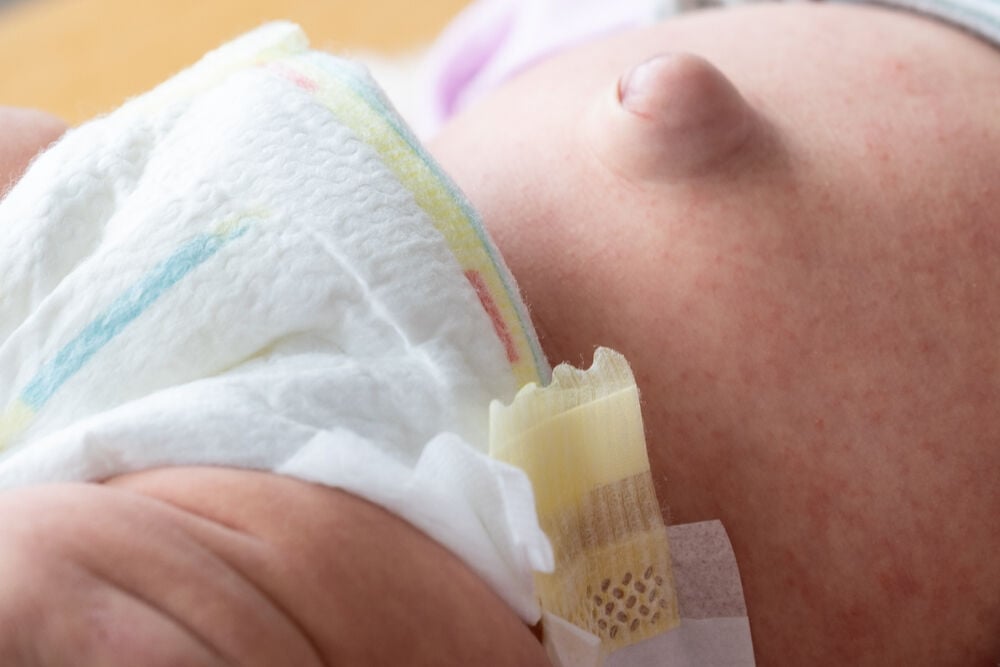Many babies are born with an umbilical hernia, and this phenomenon usually resolves without surgery. Let’s take a look with Flo at some key information about this common condition.
-
Tracking cycle
-
Getting pregnant
-
Pregnancy
-
Help Center
-
Flo for Partners
-
Anonymous Mode
-
Flo app reviews
-
Flo Premium New
-
Secret Chats New
-
Symptom Checker New
-
Your cycle
-
Health 360°
-
Getting pregnant
-
Pregnancy
-
Being a mom
-
LGBTQ+
-
Quizzes
-
Ovulation calculator
-
hCG calculator
-
Pregnancy test calculator
-
Menstrual cycle calculator
-
Period calculator
-
Implantation calculator
-
Pregnancy weeks to months calculator
-
Pregnancy due date calculator
-
IVF and FET due date calculator
-
Due date calculator by ultrasound
-
Medical Affairs
-
Science & Research
-
Pass It On Project New
-
Privacy Portal
-
Press Center
-
Flo Accuracy
-
Careers
-
Contact Us
Umbilical Hernia: Definition, Symptoms, and Treatment

Every piece of content at Flo Health adheres to the highest editorial standards for language, style, and medical accuracy. To learn what we do to deliver the best health and lifestyle insights to you, check out our content review principles.
What is an umbilical hernia?
While a baby is still in the womb, the umbilical or birth cord provides a connection to the mother through the placenta. This long tube-like structure supports the normal growth and development of the baby because it supplies oxygenated, nutrient-rich blood from the placenta.
The cord passes through a small opening between the layers of the abdominal muscles; this gap normally seals shortly after birth. An umbilical hernia results when the opening within the tissue of the abdominal muscle doesn’t fuse completely, allowing the intestines and other tissues to push through this weakened muscle.
It typically occurs around the belly button, which is why the bulge of an umbilical hernia characteristically appears in this location. Umbilical herniation is a common condition — according to some sources, as many as one in five babies are born with it.
Umbilical hernia: symptoms in babies

The most obvious sign of an umbilical hernia is the characteristic bulging that appears around the belly button. Although this can be upsetting for parents and carers, the condition is usually painless and causes no discomfort to your little one.
The distinctive sign of swelling or a bulge around the belly button is most obvious when your baby is crying, laughing, or straining during a bowel movement. These actions increase the pressure inside the abdomen, creating the opportunity for the intestines and other tissues to bulge through the gap between the abdominal muscles.
It’s important to be aware of the effect of increased intra-abdominal pressure on an umbilical hernia because the bulge may not appear when your child is relaxed.
What causes an umbilical hernia in babies?
Umbilical hernias can occur in adults when the abdominal muscles fail to close properly around the gap that allows the umbilical cord to exit. However, this condition is much more common in babies.
There is no significant difference in the frequency of umbilical hernias between girls and boys, but certain groups are more likely to experience this condition than others. These include:
- African American and Hispanic babies
- Premature babies
- Babies with a low birth weight
Take a quiz
Find out what you can do with our Health Assistant
Does a herniated belly button in babies need to be treated?
Fortunately for both parents and babies, the vast majority — up to 90 percent — of umbilical hernias disappear on their own without intervention. However, if the condition has not resolved by age five, it will need to be treated.
During a physical examination of your baby, a pediatrician or family doctor will check to see if the umbilical hernia can be pushed back into the abdomen or if it is fixed in place. These latter cases can cause complications because the tissues that are trapped within the hernia can lose their normal blood supply. In some cases, it can lead to the death of the tissues.
Sometimes, imaging studies (abdominal ultrasound or a CT scan) are used to screen for complications.
When is umbilical hernia surgery needed?
As we noted, most cases of umbilical hernia resolve on their own without surgical intervention. A health care provider is unlikely to suggest surgery unless one or more of the following are true:
- The hernia is painful.
- The hernia becomes fixed in place or blocks the intestines.
- The hernia is larger than ¼ to ¾ inch and does not show any noticeable decrease in size by age two, or it has not resolved by age five.
An emergency surgery may be necessary if the child develops pain around the hernia, tenderness, swelling or discoloration of the hernia, stiffness of the hernia tissue, and vomiting or constipation.
Surgery for a typical umbilical hernia is a straightforward procedure that lasts for approximately 20-30 minutes. The surgery is performed under general anesthesia, so your baby will be unaware of what happens during the procedure and won’t feel any pain. However, they may develop soreness around the area of the operation as they recover.
The surgeon will make a small incision in the skin near the bulge of the hernia and then push the trapped intestines back into the abdominal cavity. The procedure ends with the gap in the abdominal wall being stitched closed.
When to call a health care provider
As the parent or carer of a baby with an umbilical hernia, one of your key priorities is to be aware of the possibility of strangulation of the intestinal tissues. While uncommon, this is a serious condition that can lead to infection and, in rare cases, death.
Abdominal herniation that involves strangulation of intestinal tissues must be treated by emergency surgery. With careful monitoring, you can notice and respond appropriately to the warning signs. Be particularly alert to any of the following symptoms:
- Pain around the hernia
- Tenderness
- Swelling or discoloration of the hernia
- Stiffness of the hernia tissue
- Vomiting or constipation
If you suspect that your baby may be experiencing strangulated intestines, contact a health care provider immediately or proceed directly to the emergency room.
Umbilical hernias are a common condition in newborns and typically resolve without surgical intervention by five years of age. But if you have any concerns about your child’s umbilicus, reach out to a pediatrician or health care provider. They can address your concerns and offer advice about testing and treatment.


Hey, I'm Anique
I started using Flo app to track my period and ovulation because we wanted to have a baby.


The Flo app helped me learn about my body and spot ovulation signs during our conception journey.


I vividly
remember the day
that we switched
Flo into
Pregnancy Mode — it was
such a special
moment.
Real stories, real results
Learn how the Flo app became an amazing cheerleader for us on our conception journey.




